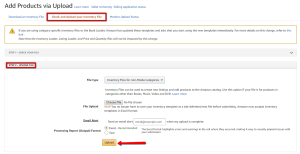Amazon Parentage
Boost Your Amazon Sales with Amazon Parentage!
Amazon Parentage is the process of grouping related product variations, such as different sizes or colors, under a single parent listing to enhance visibility and simplify the shopping experience.
Why Amazon Parentage is Essential for Sellers
- Enhanced Visibility: Grouping product variations under a single listing improves search rankings.
- Better Customer Experience: Streamlined organization makes it easier for customers to find and compare options.
- Higher Conversion Rates: Simplified shopping leads to more purchases.
- Efficient Inventory Management: Easier to track and manage stock levels.
- Reduced Administrative Overhead: Saves time and effort in managing listings.
- Increased Sales and Profitability: All these benefits contribute to higher sales and profits.
Watch our Amazon Parentage Videos
Key Points to Learn:
Challenging Vendor Central Parentage: Removing parentage from Vendor Central is harder than changing a brand name or UPC and requires filing tickets with higher-tier managers.
Regaining Control: To regain control, file tickets with affected ASINs and request to orphan child items for restructuring in Seller Central.
Key Points to Learn:
- Evaluate Parentage Options: Assess the potential risks of changing product parentage and maintain stability by focusing on two options: keep the current parentage or break size off while grouping colors together.
- Define Customer Avatar: Clearly identify and specify the customer avatar to ensure effective targeting, using relatable metaphors to enhance understanding of the target audience.
Key Points to Learn:
- Caution Against Parentage: Discourage brands from parenting items with many reviews, as it can lead to decreased visibility and sales due to limited search coverage.
- When to Parent: Recommend parenting for new product launches to leverage the existing listing’s sales performance for a better market entry.
Key Points to Learn:
Effective Parentage Strategy: Optimize product listings by prioritizing color over size variations to enhance customer decision-making and potentially increase conversion rates.
Learn from Past Challenges: Analyze sales impact from previous UPC and listing merge errors, emphasizing the importance of strategic adjustments to regain lost rankings and sales momentum.
Key Points to Learn:
Break Parentage for Visibility: Separate SKUs driving significant sales to enhance search rankings and product visibility.
Manage Brand Registry Access: Ensure proper global user permissions for effective use of Brand Registry and Brand Analytics across multiple selling accounts.
Key Points to Learn:
Ensure Category Consistency: Reviews won’t combine if product types or categories don’t match. Make sure all products in the parentage share the same category.
Follow Up on Brand Registry Tickets: If the issue persists, submit a Brand Registry ticket to request merging reviews. Be ready for auto-declines and provide additional justification to improve your chances of success.
Key Points to Learn:
Optimize Parentage Titles: A well-optimized parentage title with relevant keywords is crucial for improving visibility on Amazon and search engines, directly impacting sales.
Beware of Rebuilding Parentage: Changing or rebuilding a parentage can lead to a decrease in sales if the new parent ASIN loses visibility, especially for mature listings.
Key Points to Learn:
Use Suitable Parentage Types: Opt for size, quantity, and color parentage types to ensure unique images for child ASINs. Avoid complex variations that may cause shared images.
Default Child Model (DCM): Ensure your listings use a DCM for unique child information. If stuck in a Default Parent Model (DPM), contact Amazon support to request a switch to DCM.
Key Points to Learn:
UPC Field Importance: Populate the UPC field correctly during template uploads to avoid data issues in Seller Central.
Request Category Listings Export: Enable the Category Listings Export report by filing a ticket with Amazon support to back up and troubleshoot your product data.
Key Points to Learn:
Reviews Stored at Child Level: Reviews are tied to individual child ASINs, not the parent ASIN. If a child ASIN is re-parented, it retains its reviews.
Review Merging Changes: While reviews from child ASINs can merge for customer perception under a parent ASIN, many categories have stopped this practice, leading to more frequent parentage breaks.
Key Points to Learn:
Shared BSR Misconception: All variations in a parentage listing share the same Best Sales Rank (BSR), making it difficult to accurately assess individual sales performance and leading to potential miscalculations in revenue estimates.
Top Seller Identification: To find the best-selling variation, use relevant keywords to search on Amazon; the product that appears first is likely the top seller due to higher conversion rates.
Key Points to Learn:
Theme Change Flexibility: Sellers can now change a parentage variation theme (e.g., from color to size) without deleting the parent SKU, simplifying the addition of new variations.
Complexity of Parentages: Managing parentages, which connect multiple variations, is complex but essential for optimizing product listings and improving customer experience.







